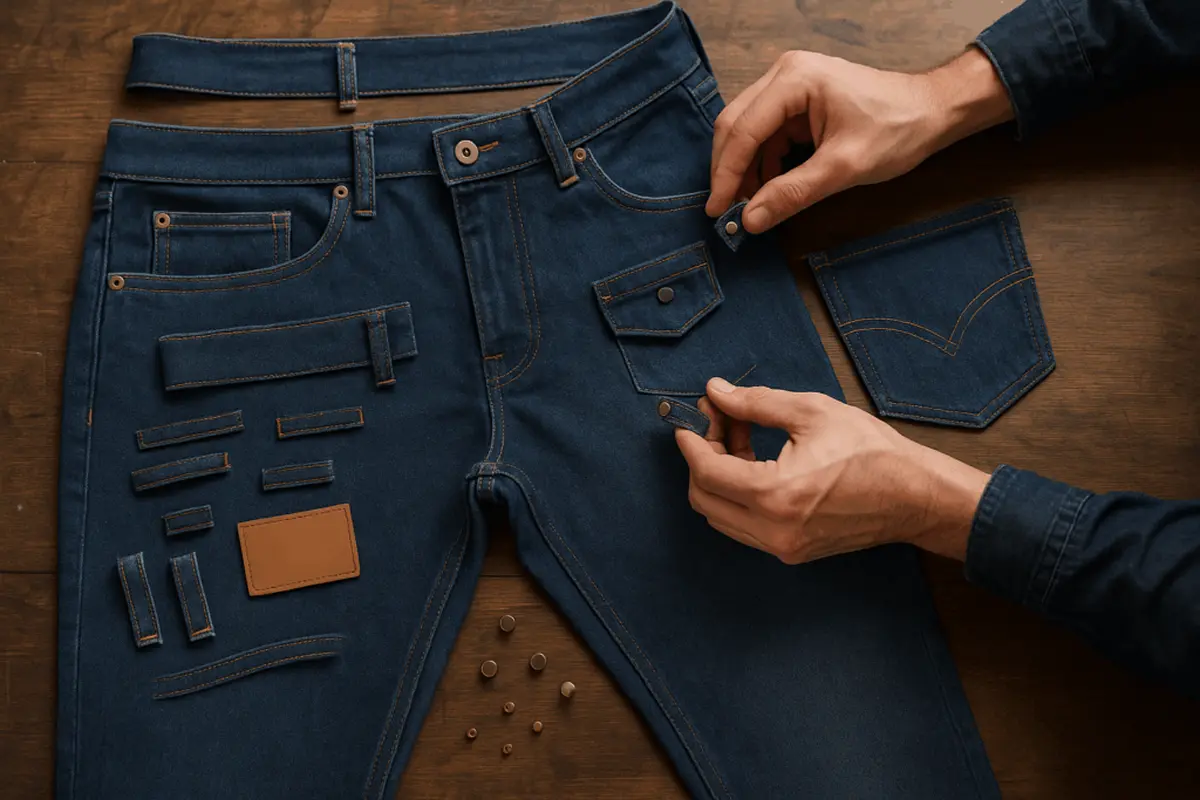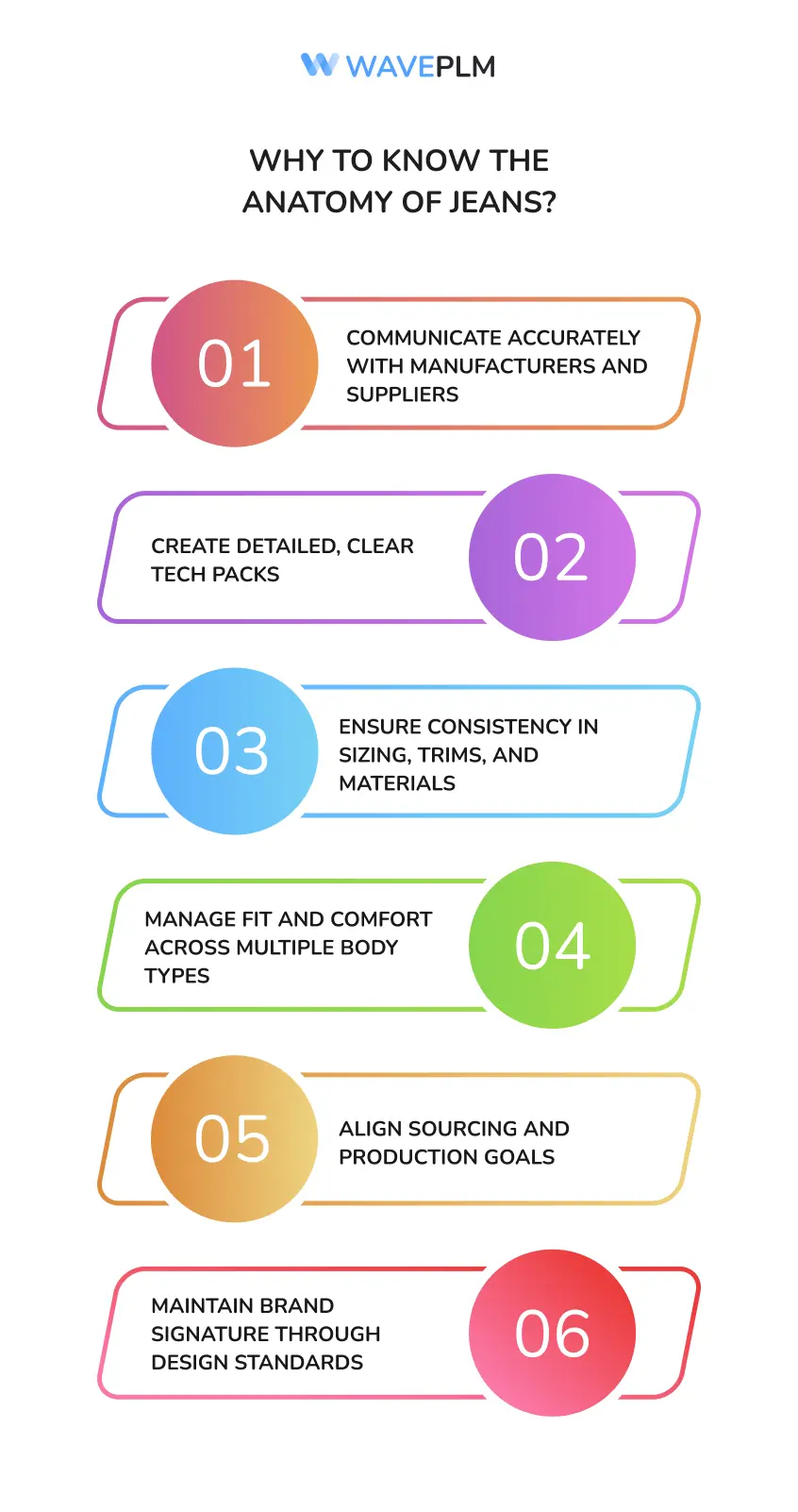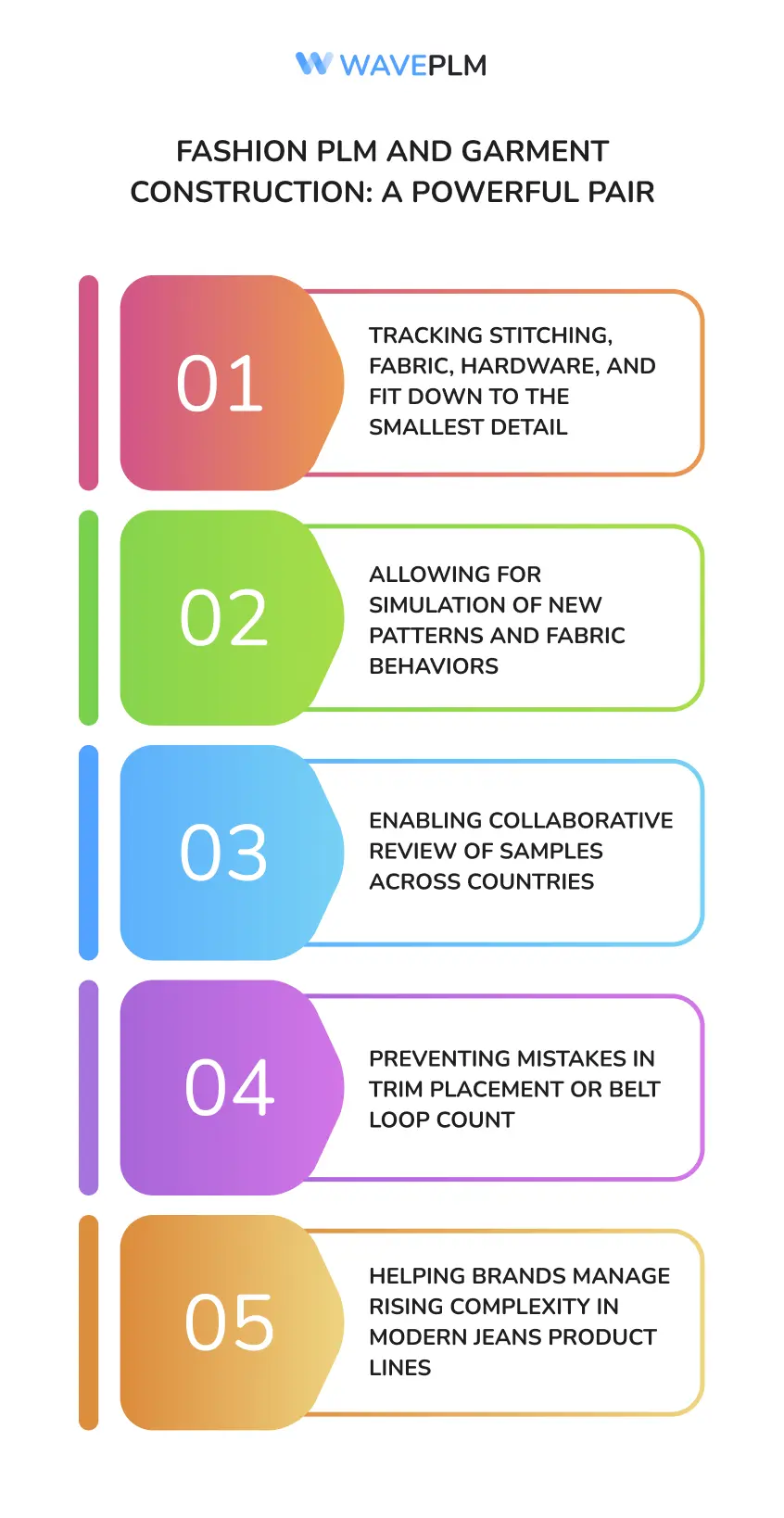
Introduction
Understanding the anatomy of jeans is essential in denim design, development, and production. Jeans are more than just pants—they are a carefully engineered product of precision in garment construction, thoughtful jean design, and advanced fashion PLM integration. Each component of a pair of jeans has a specific function and visual identity. Recognizing these parts is vital for product developers, designers, sourcing agents, and patternmakers. This article breaks down every aspect of the parts of jeans, explains their role in construction and wear, and shows how PLM software helps modern brands manage this information.
Why Know the Anatomy of Jeans?
Having a deep understanding of the anatomy jeans are built upon empowers fashion professionals to:
- Communicate accurately with manufacturers and suppliers
- Create detailed, clear tech packs
- Ensure consistency in sizing, trims, and materials
- Manage fit and comfort across multiple body types
- Align sourcing and production goals
- Maintain brand signature through design standards
Incorporating this knowledge into fashion PLM platforms creates seamless communication between design, development, and production teams, ensuring every department shares the same source of truth.

Table: Common Parts of Jeans
|
Component |
Description |
|---|---|
|
Waistband |
Top edge that wraps around the waist, often with belt loops to hold a belt |
|
Yoke |
V-shaped panel below the waistband that shapes the seat |
|
Rivets |
Metal fasteners that reinforce stress points, especially on pockets |
|
Inseam |
Stitch running from crotch to hem inside the leg |
|
Outseam |
Side stitch from waistband to hem |
|
Fly |
Opening at the front, closed by zippers or buttons |
|
Coin Pocket / Watch Pocket |
Small inner pocket nested inside the front pocket, also known as a watch pocket |
|
Back Pockets |
Two rear pockets (pocket corners are reinforced by rivets or bar tacks) |
|
Rise |
Measurement from crotch to top of the waistband |
|
Hem |
Bottom edge of each leg, sometimes raw or folded and stitched |
This structure forms the base of all modern jeans, allowing for style variation while retaining familiar function.
Jean Construction: Stitch by Stitch
Constructing a pair of jeans involves much more than sewing pieces together. High-quality jean construction uses:
- Double and triple stitching for durability and aesthetics
- Strong seams such as the flat felled seam for added reinforcement
- Hidden bar tacks and two rows of stitching in stress areas
- Pre-washing and distressing techniques for character and feel
- Specialized hardware: shank buttons, copper rivets, metal zippers
Using PLM software to track and visualize these construction choices ensures that everyone—from designers to factory technicians—understands how the final garment should be made. Brands can attach visual instructions, seam samples, pattern files, and even QA protocols.
Denim Components and Their Function
Every denim component serves both aesthetic and practical purposes:
- Waistband: Holds the garment at the waist, often features belt loops and branded tags
- Yoke: Allows better fit over the seat; common in Levi’s jeans and most five-pocket designs
- Fly: A frontal opening reinforced by a J stitch or double lines, secured by zippers or buttons
- Rivets and bar tacks: Strategically placed to reinforce stress points
- Back pocket: Designed with shape, embroidery, or branding; sometimes with arcuate stitching
- Coin pocket/watch pocket: Small front pocket, rooted in Levi Strauss history
- Hem: Can be a raw edge or a clean folded stitch, depending on design
- Self edge/selvedge: Edge of high-quality raw denim, visible when cuffed
Brands that utilize fashion PLM can store each component in a centralized system, attach references and samples, and control change requests efficiently.
How PLM Software Supports Jean Design
Fashion PLM is indispensable in organizing all moving parts of jean design. From idea to sample, it tracks:
- Fabric selections, including denim fabric, twill fabric, or raw denim
- Technical specifications of stretch, weight, and shrinkage
- Trim libraries: rivets, zippers, shank buttons, branded leather patches
- Fit blocks for different body types: slim, relaxed, low rise, high rise, curvy, etc.
- Wash instructions and fade expectations for blue jeans and raw denim
This platform helps brands reduce errors, minimize back-and-forth with vendors, and maintain a consistent design vision through smart version control and real-time updates.
Template: PLM Tech Pack Example for Jeans
|
Section |
Details |
|
Product Name |
Classic Mid-Rise Slim Fit Jeans |
|
Fabric |
98% cotton, 2% elastane, 12 oz denim twill |
|
Color |
Indigo Blue |
|
Stitching |
Chain stitch, flat felled seam, two rows at seams and pockets |
|
Trims |
Branded shank button, copper rivets, metal zippers |
|
Labels |
Main label (woven), size label (printed) |
|
Size Range |
US 24-32 |
|
Fit Notes |
Mid-rise, fitted through top block, narrow leg |
|
Care Instructions |
Machine wash cold, tumble dry low, do not bleach |
This digital tech pack allows internal teams and external factories to work from one unified document. For large brands or those working with multiple vendors, a tech pack in PLM ensures no missed details.
Denim Terminology: What to Know
Here’s a complete guide to essential denim terminology that will help professionals across fashion roles communicate clearly:
- Right hand twill: Most common weave for denim, runs upward to the right
- Weft yarn: Horizontal thread woven into the vertical warp in twill fabric
- Raw denim: Untreated, dark denim that fades with wear and creates personalized lines and folds
- Top block: The area from waistband down to upper thigh, key to comfort
- Five pockets: Two front, two back pockets, and one coin pocket—the traditional design
- Coloured thread: Contrast thread, often orange or gold, for signature look
Understanding these terms helps teams write accurate documentation and describe product specs efficiently.
Fashion PLM and Garment Construction: A Powerful Pair
Using PLM software to manage garment construction brings measurable results:
- Tracks stitching, fabric, hardware, and fit down to the smallest detail
- Allows for simulation of new patterns and fabric behaviors
- Enables collaborative review of samples across countries
- Prevents mistakes in trim placement or belt loop count
- Helps brands manage rising complexity in modern jeans product lines
PLM software isn’t just digital storage—it’s a strategic tool that helps brands innovate, scale, and maintain quality in a competitive market.

SEO FAQ: Anatomy of Jeans
Q1: What are the different parts of jeans?
A: Waistband, belt loops, yoke, fly, inseam, rivets, back pockets, coin pocket, watch pocket, and hem.
Q2: What is the structure of jeans?
A: Jeans use a combination of panels, seams, and reinforcements. They are held together with flat felled seams, bar tacks, and durable stitching.
Q3: What are the little metal things on jeans called?
A: They’re called rivets. These strengthen stress points, especially near pocket corners and belt seams.
Q4: What is the yoke on jeans?
A: It’s a V-shaped panel below the waistband that shapes the rear and affects how jeans fit over the hips.
Q5: Why does raw denim fade?
A: Because it is unwashed, raw denim fades over time with wear, creating high-contrast fades, creases, and folds unique to each person.
Conclusion
Understanding the anatomy of jeans gives you control over design, communication, and quality. From denim components like belt loops, waistbands, and rivets to advanced garment construction, these insights are the foundation of successful jean design.
Using fashion PLM, you ensure every part of the process—design, tech pack creation, sample management, and bulk production—is traceable and consistent. Whether you’re designing Levi’s jeans, developing a new raw denim capsule, or managing complex retail planning, knowledge of jeans’ construction will always pay off.
Want to build better jeans with less effort? Book a demo with Wave PLM and see how we empower denim teams worldwide.





Leave a Reply